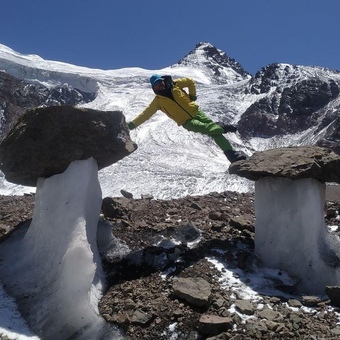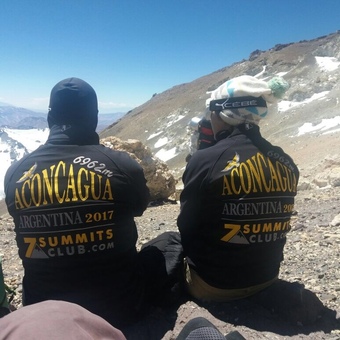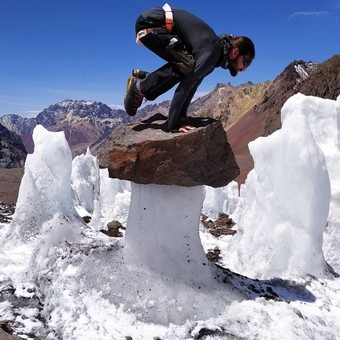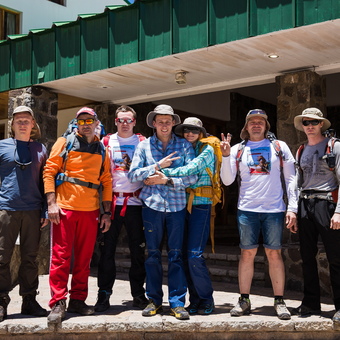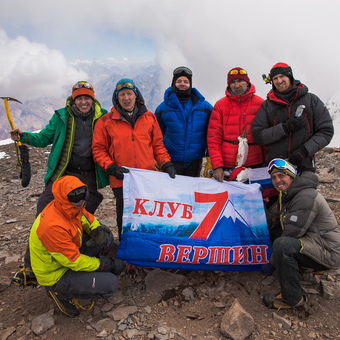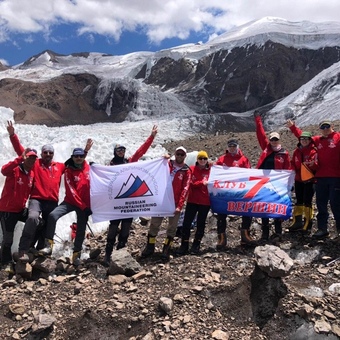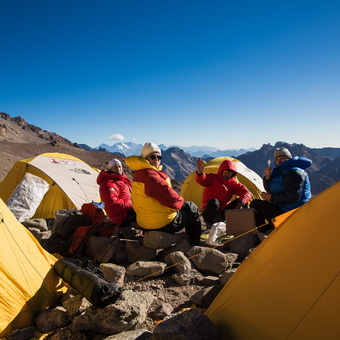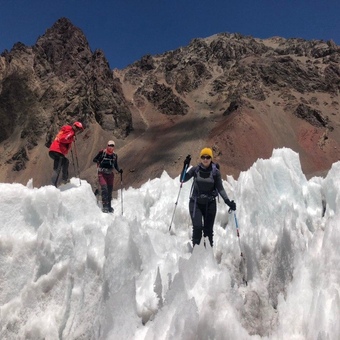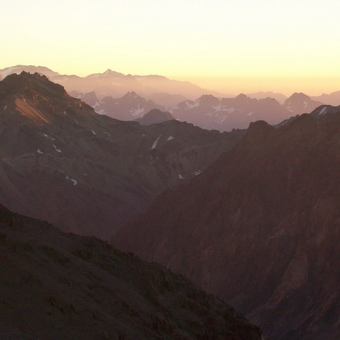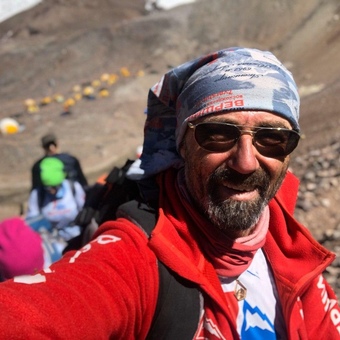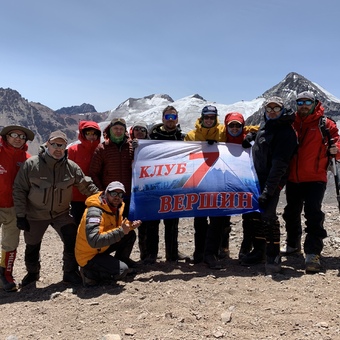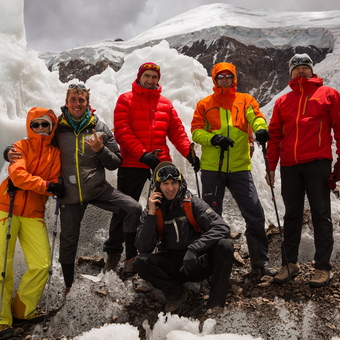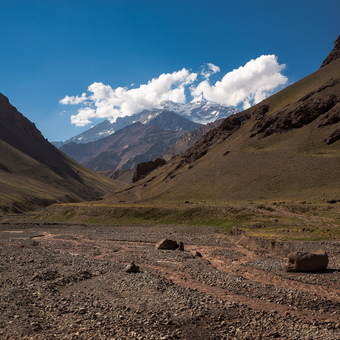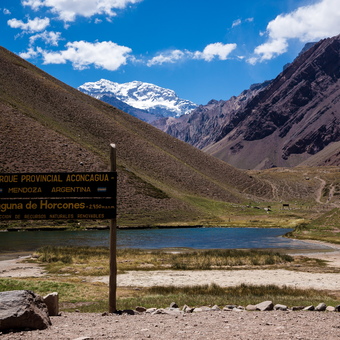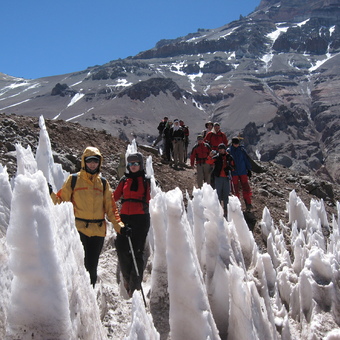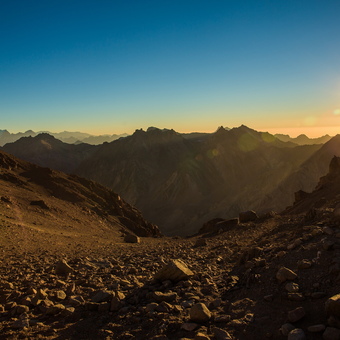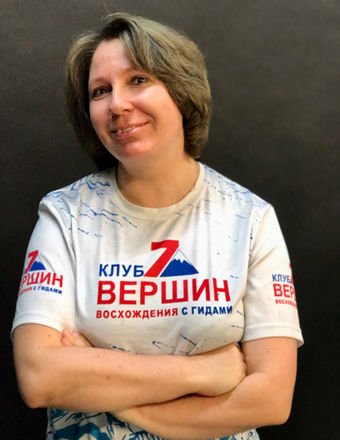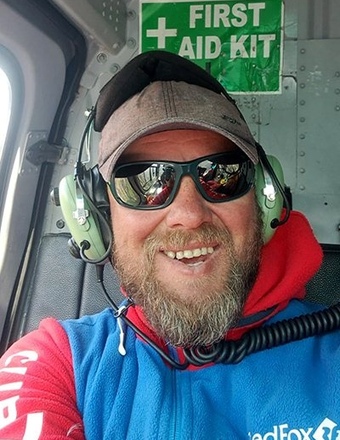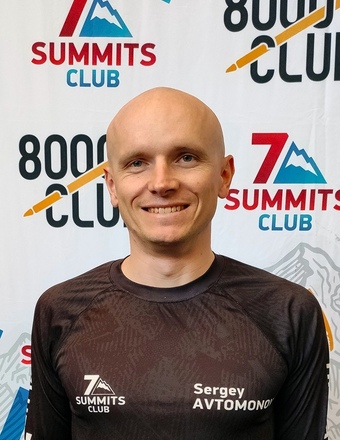Aconcagua climb
Aconcagua is the highest mountain of two Americas (6,962 m), and the highest mountain outside Asia. Aconcagua is entirely located within the Republic of Argentina, province of Mendoza, Department of Las Heras. It is one of the Seven Summits. In mountaineering terms, Aconcagua is an easy mountain if approached from the north, via the normal route. Although the effects of altitude are severe…. Almost 7km in altitude it can be walked all the way to ...
Long trek (8-9hr) to the Base Camp at Plaza de Mulas (4250m). The way is along the wide valley of Playa Ancha. Night at Camp
Deposit for reservations 1 000 $
Full payment 60 days before
No refund if you cancel less than 60 days!
Price includes
• Transportation in a private bus/minivan from Mendoza to Penitentes and back.
• Help in obtaining the necessary climbing permits
*Two nights at Mendoza (Diplomatic hotel)
• Night in a hotel in Penitentes (double rooms, breakfast&dinner) or a night in Aconcagua Vision's luxury camp.
• Transportation from Penitentes to the Laguna de
Horcones trail
• Mules for food and equipment from Puente
del Inca (Los Puquios) to Plaza de Mulas and back.
Load limit - 30 Kg
• Two nights in Confluencia: electricity, cook, meals&drinks, mess tent with tables, chairs and tableware, toilet tent
• Service in Base Camp in Plaza de Mulas (number of nights limited to 5): electricity, cook, meals&drinks, mess tent with tables, chairs and tableware, toilet tent, storage of personal things, radio communication
• Four-season tents, stoves, cookware and tableware
• Food for high camps
• Mountain guide from 7 Summits Club (Aconcagua
summiter)
• Radio communication between BC, Mendoza and Puente del Inca: for co-ordinating the expedition logistics
- Medal for successful climb
Price does not include
• Airfare and airport taxes to and from Mendoza
Regular service bus tickets to and from Mendoza
• Climbing permit
• Personal porters in high camps (up and down)
• Individual gear
• Extra costs entailed by leaving the expedition prematurely
• Medical insurance covering all climbing risks to 7000m, costs of eventual rescue operations and helicopter evacuation expenses.
• Personal expenses (drinks, laundry, mail,
telephone calls etc)
* extra night in Mendoza (if a reserve day is not used)
Argentina, Aconcagua (6962m), Mountaineering
Trip overview
Mendoza (700m)– Penitentes (2700m)– Aconcagua Provincial Park - Confluencia(3300m) – Base Camp Plaza de Mulas (4250m)– Plaza Canada (4900m) – Nido de Condores (5500m) – Berlin (5900m) – Summit of Mt. Aconcagua (6961m)
Why go there?
Aconcagua (6961m) is the highest mountain in South America, one of the 7 Summits. It is located in Argentina in the Province of Mendoza. The name may have come from several possible origins: Kon-Kawa (“Snowy Peak”) - from the Argentine aboriginals, the Aymara; Aconca-Hue (“Coming from Other Side”) – from the Chilean Araucano; Akon-Kahuak (“Sentinel of Stone”) – from the Quechua.
From the top of this mountain, you can revel in the breath-taking views of the amazing white ranges of Cordillera de Los Andes.
As a climbing objective Aconcagua offers a rich variety of interesting routes of all the technical levels. The Normal (or NW) Route is physically very demanding, but not really technical.
Route description:
Our expedition starts in the town of Mendoza. On arrival we have an overnight stay in Diplomatic hotel to obtain climbing permits. On day two we drive to Penitentes (a small village next to Puente del Inca) and on the next day the climb starts (by NR). We stay two nights in Confluenca Base Camp (3300m) and, for better acclimatization, two nights in Plaza de Mulas Base Camp (4350m). After that with the help of experienced guides and porters we begin to establish high camps: Canada (4900m), Nido de Condores (5500m) and Berlin (5900m). On the 12th day we make a bid for the summit. And of course we have a reserve day to make up for bad weather. The expedition ends in Mendoza, where we stay for one night before saying a hearty thankful good-bye to these places.
7 Summits Club on Aconcagua. 2004.
Good advice
Booking deposit, 50% of the price, is paid not later than 3 months prior to expedition. Balance payment is due not later than 45 days prior to expedition
Tips guidelines (important information!)
You entrust your life, health, your time and money to the guides. And the guides take this responsibility for you and for the success of the whole trip. They are doing this 24 hours.
10-20 USD per day is expected as the normal amount of tips for the Guides and the staff of the program. If you liked everything about the trip, please don't forget to thank them. You can give the tips directly to the Main Guide and he will distribute it among the staff.
Necessary travel papers (documents)
Passport to travel abroad
Argentine visa (if necessary, depends on your citizenship)
Special questionnaire
Medical and climbing insurance covering all climbing risks and helicopter evacuation.
By air and by land
You can get to Mendoza by many international flights (via Santiago de Chile (SCL) or Sao Paulo), by domestic flights from Buenos Aires and by bus from Buenos Aires or Santiago.
Accommodation
2 nights in hotels (SNG, BB)
16 nights camping (DBL, FB)
Meals
Breakfasts in the hotel, full board while in camps
Staff
Mountain guide from 7 Summits Club,
porters helping to pitch high camps, cooks and kitchen staff, muleteers
Health and medical insurance
Our guide will have a first aid kit and we strongly recommend to bring your own specific medicines you might need. Besides, we recommend to start taking polyvitamins 3 weeks before the expedition. Also would be very useful to try to acclimatize on some peak over 5000m and test your system before you come to Aconcagua.
Weather
The normal time for expeditions is from December to March. A colder month could be better in terms of weather, normally
more stable when cold.
Generally from December to March. Experience indicates that, if the "peak" months are the coldest, its climate is more stable. It would be good to calculate correctly the time you have available, including some days of "reserve" to wait for good weather in case of storms. A "bonnet of smoke", white wind over Aconcagua`s top, is a sign of tempest in the heights and you must not go further on.
Extra expenses
Permit (between USD 800-900, depending on your nationality and the start date of the climb), see http://formulariosambiente.mendoza.gov.ar/images/aconcagua/tarifas/TarifasPPA2018-19.pdf for the latest fees.
Possibility of renting personal equipment
There are several local gear shops with good gear, but in the high season many popular sizes and items can run out, so it is best to bring as much of your own gear as possible.
Personal gear
Personal gear:
Heavy-weight fleece / pile jacket
Light/medium-weight, long thermal underwear shirt (polypropylene/capilene)
Long underwear shirt, medium weight fleece shirt,
Water proof / breathable jacket with hood (Gore Tex is strongly recommended)
Long sleeve, light weight shirt
Down or hollow fiber filled jacket with a hood, large enough to put on over a fleece jacket
Fleece pants (with full side zips to allow ventilation)
Two pairs of long underwear pants (one light-weight and one medium-weight)
Waterproof / breathable pants (or bib pants) with full side zips for easy putting on and taking off
Light weight trekking boots
Climbing expedition boots
Crampons (well fitting, preferably “step-in”) with a maintenance&repairing kit
2-3 pairs of liner socks
3 pairs of wool or poly socks (medium-heavy thickness)
Gaiters
2 pairs of liner gloves
Medium weight fleece gloves
Nylon shell gloves
Wool or fleece mittens
Shell overmitts
Thick hat (wool or fleece)
Balaclava
Glacier glasses
Extra pair of your ordinary glasses (if you wear them)
Down or hollow fiber filled sleeping bag good for 10-20 degrees Fahrenheit
Sleeping pad, either a Therm-a-Rest, or a closed-cell foam pad
Head torch
Two water bottles 1 liter each (with insulators)
Duffle bag (120 L)
One day back-pack (35-45 L, should be big enough to hold two
liters’ thermos, a snack, extra clothing, and a camera for
the summit day)
Telescopic ski poles
Crampons
Helmet
Glacier cream (spf 40)
Your specific first aid kit
Lip balm (spf 25+)
Favorite lightweight snacks
Camera and accessories
Book, playing cards, walkman, reading stuff etc.




